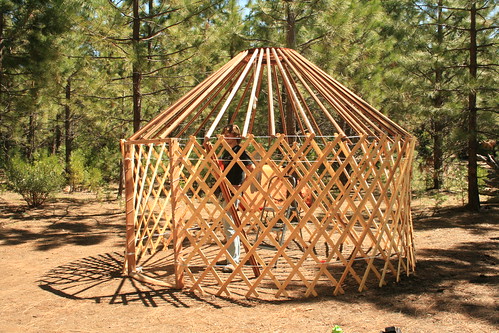
Setting up the yurt frame on a nice level area.
I finally got another chance to take the yurt camping, this time in the Stanislaus National Forest near the Hwy 120 entrance of Yosemite National Park in California. My dad and I searched for hours, driving down national forest roads, to find the perfect spot to set it up. We encountered a lot of steep terrain which was not ideal to set up the yurt, since it needs to be as level as possible. If the ground isn't level, then the roof will end up pushing down more on the khana downslope, causing uneven stresses on the frame. We were also looking for a spot with flat ground (not bumpy) and cleared of vegetation. We finally found a spot near Camp Mather, off of Evergreen Rd.
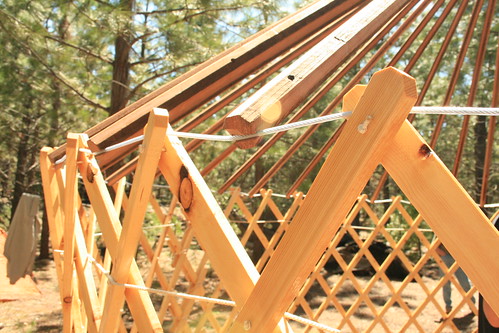
A close up of how the roof poles rest on the tension cable.
Unfortunately, before we got everyone together at our campsite, it was already past midnight. We spent the whole day looking and didn't get everything together to start building the yurt until after dark. So we slept in tents and the next morning, we started building. We had plenty of time, and spent about two hours putting it up. Even though we tried building the yurt on a spot as level as possible, the ground was still slightly at an angle, but what can you do? We built the door downslope so that our heads when we sleep inside the yurt would be away from the door.
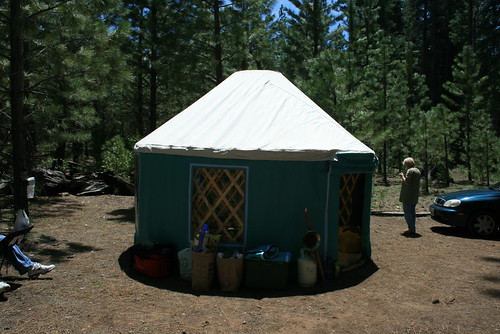
All done! The door is rolled up.
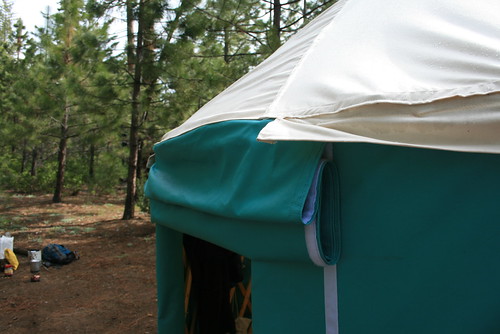
Close up of the rolled up door.
We also tried a new way of rolling up the door. It was pretty simple, in fact. All we did was roll up the door from the outside, and then unfold the roll at the top so that some of the velcro was stuck to the velcro of the walls. This small amount of velcro (about 3-4 inches) was strong enough to hold up the entire rolled up door. It worked well, and we didn't need any ropes to cinch it up as we originally thought. Also, the Sierra Nevadas are a really dry mountain range with few bugs, so we were able to keep the door open all day and the only bugs that crawled into the yurt were a few large ants. If we end up taking the yurt anywhere else, I will consider making a screen door insert.
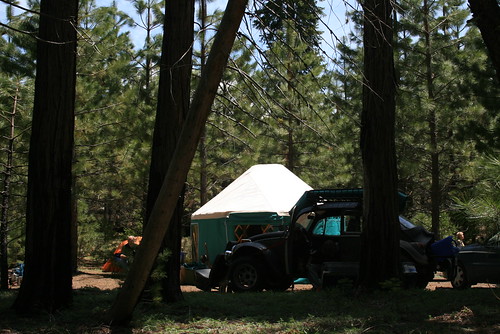
Our camp spot in the forest.
Now, as the title of this post suggests, it rained on the yurt while we were camping. It didn't rain really hard, but it did drizzle for a few hours, and there were interspersed periods of heavy rain that lasted 1-5 minutes. I was very excited when it rained because this meant I would be able to see how the yurt stood up to the water, and if the canvas was really as water resistant as I've heard. My mom was relaxing inside of the yurt at night while it was raining and she said the sound of the rain on the roof was very relaxing. The rain drops that hit the canvas balled up and rolled off. The canvas soaked up very little of the water. The area where the most water was actually soaked up by the canvas was at the roofline where the canvas was stretched tightly around the end of the roof poles at top of the walls. Some dirt got splashed up off the ground and hit the bottom band of the yurt wall. But since this section was made of vinyl, it was easy to wipe off. The walls also got wet, but the water just rolled down and never soaked in. The next day was sunny and warm, so the yurt dried out completely.
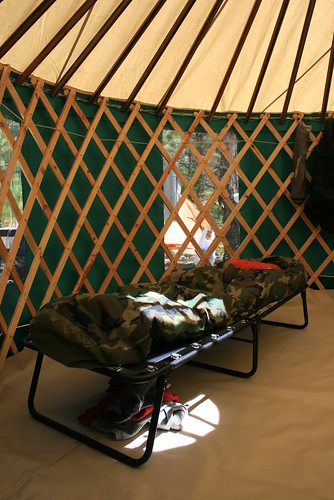
Setting up the cot inside.
Another thing we tried for the first time is sleeping on a cot in the yurt. This was actually really nice and made it feel like a house or cabin in the woods rather than a fancy heavy duty tent. Sleeping on the ground still makes you feel a bit more like you're camping in a tent, but the cot was great. It also added the benefit of putting stuff under the cot which freed up floor space.
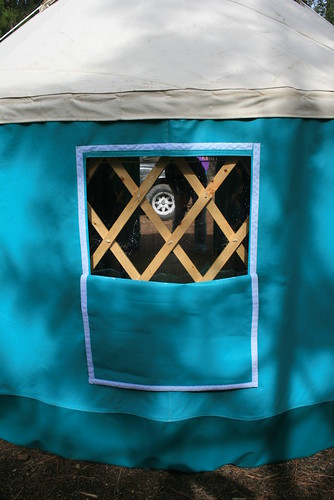
A window cover halfway on.
Since it was hot during the day, about 75 degrees and sunny, we wanted to keep the yurt as cool as possible, which was hard since it was in the direct sun around noon. We tried covering the south facing windows with the window covers I just finished before we left on the camping trip. This worked pretty well, and kept the yurt a lot cooler than if the windows were open to the sunlight.
Finally, as we packed up, we noticed that the ground underneath the yurt was really moist, probably from all the rain and the recently melted snow in the area. The vinyl floor and the vinyl bottom band of the walls were very wet when we were packing up the yurt and some parts were covered with mud and wet soil. This shows the importance of the vinyl bottom band, because it doesn't allow the water in the ground to be soaked up by the canvas of the walls since vinyl doesn't absorb any water. It was very easy to take a rag and wipe down the mud/water from the vinyl floor and bottom band when we were packing up, ensuring that the yurt was packed away dry.

Коли приїдете в Україну?
ReplyDelete